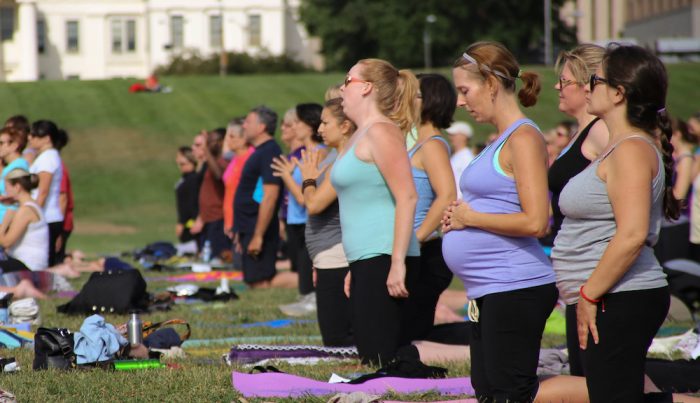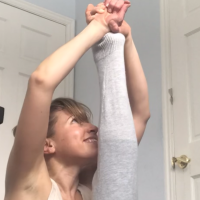I’m not the same yoga teacher I was a year ago. I think it’s got a lot to do with the fact that I’m not the same student.
A few years ago I moved to Boulder, Colorado, and began getting my feet wet with Mysore-style ashtanga yoga. Over the last eight months in my new home in the greater Washington, D.C. area, I’ve committed to practicing and studying Mysore-style Ashtanga like never before. I’m also a yoga teacher, though primarily I teach Vinyāsa. As I reflect on the last six months I have just spent practicing and teaching in D.C., I am struck by how different I feel as a teacher and how differently I feel now about teaching.
I think my practice has just about everything to do with that.
Let me nip something in the bud first—I am not making any statement that one yoga style makes for better teachers. I recognize that what I write here is not necessarily exclusive to Mysore-style Ashtanga. I respect the many different paths there are in yoga to suit different individuals. I have to write from my experience, though, so here it is. Here’s why practicing Ashtanga has made me a better yoga teacher:
1. Repetition. Sounds so boring, doesn’t it? It’s not. Repeating the same postures day in and day out means you get to know them really, really, well.
Repetition of the primary series has made me see that just because I can do something, does not mean it’s ‘done.’ Instead, I’ve discovered that the first time I achieve or get myself into a certain posture, is only the beginning.
Now, once I get the feeling that I’m ‘done’ in any way with a pose or transition, I start looking for ways to make it challenging again. Don’t get me wrong, even though I am tough on myself, I am just as prone to cheating and artful dodging (I’m stealing that one from David Garrigues) as the next guy. So when I have time to reflect, I’m asking myself, where am I ‘half-assing’ it in my practice? There’s always a way to evolve it forward. As an example, learning to find the challenge in the poses that come most easily to me, like backbends, for example (and the Ashtanga sequence has helped me to do just that) has given me more tools for teaching them.
And then…there are just the discoveries that come when you’re in the thick of your own practice.
Take triangle and extended side angle, for example. That’s right, good old fashioned standing postures. There’s nothing sexy about these poses; they’re not the postures you see yoga teachers choosing for their Facebook profile photos. But I feel these poses these days like never before—and I am teaching them from this place. I’m teaching these poses from my own practice. What I’m teaching now isn’t scripted, but real.
2. Direct, regular relationship with a teacher. Over the years I’ve wondered what kind of mystique my dearest Vinyasa teachers possessed that enabled them to connect so well with the students in their popular and crowded classes. Maybe it’s because these teachers had a history of their own Mysore or self-practice—or, just natural gifts for connecting and compassion. Whatever they had, I found myself unable to copy it. Maybe I needed a more direct, more visceral teaching of this ‘je ne sais quoi.’
I got it in the Mysore room. I began to get excited about practicing because I knew I would get these mini-private lessons along the way—and believe you me, I have placed just about all these mini-private lessons in my teacher toolbox file. I have wanted to give others the feeling these teachers have given me—that of being taken care of even as I’m being taught how to take care of myself.
Of course, I don’t have the honor of teaching Mysore-style. In a Vinyasa class, I cannot stop and give a mini-private lesson to every student in the midst of our 75 minutes. So, how does what I have learned from Mysore leach into my teaching a led vinyasa class?
More and more, I converse with my students before and after class about their practice, about things that particular student is working on or dealing with. More and more I teach in the moment. More and more I try to take care of my students before moving in for an adjustment—asking myself, what do they really need? Maybe not so much. Maybe just a few verbal cues suffice. More and more I respect where they are instead of where I might want them to be.
3. Respect for the individual. I’m developing a sense of respect for the power and innate wisdom of each individual who walks through the door of a class that I am teaching. This, I shamefully confess, may be a more recent development in my life as a teacher. It’s the result of several things, but in a big way from supta kurmasana. A sticking point pose for many in the primary series, this pose requires both legs behind the head with your hands bound behind your back, while lying on your belly.
Sound ridiculous?
I sure thought so. Especially since this stupid pose was the one thing keeping me from advancing to the intermediate series (my teacher wanted to see me get into the pose unassisted.) Oh, how I got frustrated! Frustrated to the point where I decided to figure it out. I decided to take all the tips, tricks and methods that teachers had passed on to me, and apply them to my own body. And figure it out I did! It was a method no one had precisely taught me. I devised it based on study of others’ methods and study of my own body and proportions.
This experience gave me a deep sense of my own power and wisdom. A teacher didn’t give me the pose—I did. What he did in asking me to put myself into the pose, was reveal his confidence that I could do it all by myself. It revealed his desire that I be able to proceed through my practice with minimal assistance. I see now that just as the teachers I knew didn’t have all the precise recipes for me, I don’t necessarily have the precise recipes for anyone either. I don’t have all the answers as a yoga teacher. The best I can do is give someone the space to find their own answers, and maybe a little faith that they can, in fact, find them.
4. Finding Balance. The balance between effort and ease, pushing versus coddling, love versus duty, self-agency and surrender. Do I take a day off because I haven’t slept a wink all night or do I get up and practice? Do I rest this injury or modify my practice? Do I want to do this because I love it or because I think it’s something I should do? How much do I surrender to this teacher, this system of yoga, and what do I keep of myself?
Mysore practice has brought me nose to nose with these questions. That’s what happens when you take on a practice that’s part of a system, particularly one that for some reason typically involves practicing at the crack of dawn on a super-empty belly six days a week.
In case you got excited, I should warn you right now that I don’t have all the answers to the questions above. I am, however, better at navigating these uncertainties, and better able to encourage others to find their own sense of balance. I don’t assume it will be the same as mine.
Frankly, the practice of Mysore-style ashtanga has made me a better student. I am embarrassed to admit this, but it used to be that when I took another yoga class, I would find myself mentally standing there, with a clipboard, taking notes on the class. Did I like this? Check. Did I not like that? Check minus.
Now, when I take a class, which I still do in addition to Mysore practice from time to time, I’m more likely to surrender to the experience as a student. But I’m a big girl, and I don’t give it all away. I’m not going to do something that will be a disservice to my body just because some teacher tells me to.
5. Self-practice. This is the heart of everything. I practice, on my mat, in my own head, with my own breath, with my own body and with occasional assistance from a teacher. I’m not just doing postures, the postures are living and breathing and evolving everyday through me. I know these postures, and that means more than just checking them off a list as ‘done’ but knowing that they are changing and evolving always. I know what it is like to practice and be left alone (or actually be on my own), versus when a teacher steps in to assist. I have a sense of my own power, my own wisdom and my own scrappiness from this practice that has revealed how I have just as many answers inside me as I do questions. I have the regular experience of myself as both teacher and student at the same time on my mat.
Perhaps the latter is the most important part. In a way, I bristle at saying that practicing Mysore-style Ashtanga has made me a better yoga teacher. I’m not really comfortable with that. What I mean, really, is I feel better in my own skin as a teacher, and as a student.
So maybe I should just say it’s made me a better student. Or, maybe just a better person.
Or, how about just…better?
Like elephant Ashtanga on Facebook
Ed: T. Lemieux/Kate Bartolotta
Ready to join?
Hey, thanks so much for reading! Elephant offers 1 article every month for free.
If you want more, grab a subscription for unlimited reads for $5/year (normally, it's $108/year, and the discount ends soon).
And clearly you appreciate mindfulness with a sense of humor and integrity! Why not join the Elephant community, become an Elephriend?
Your investment will help Elephant Journal invest in our editors and writers who promote your values to create the change you want to see in your world!
Already have an account? Log in.
Ready to join?
Hey, thanks so much for reading! Elephant offers 1 article every month for free.
If you want more, grab a subscription for unlimited reads for $5/year (normally, it's $108/year, and the discount ends soon).
And clearly you appreciate mindfulness with a sense of humor and integrity! Why not join the Elephant community, become an Elephriend?
Your investment will help Elephant Journal invest in our editors and writers who promote your values to create the change you want to see in your world!
Already have an account? Log in.
Ready to join?
Hey, thanks so much for reading! Elephant offers 1 article every month for free.
If you want more, grab a subscription for unlimited reads for $5/year (normally, it's $108/year, and the discount ends soon).
And clearly you appreciate mindfulness with a sense of humor and integrity! Why not join the Elephant community, become an Elephriend?
Your investment will help Elephant Journal invest in our editors and writers who promote your values to create the change you want to see in your world!
Already have an account? Log in.
 Share on bsky
Share on bsky






Read 16 comments and reply